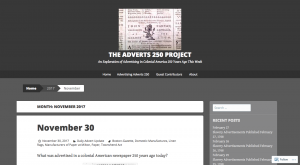An Exploration Of the Adverts 250 Project
What is this digital public history exhibit about?
The Adverts 250 Project is a digital exhibit concerning “an exploration of advertising in Colonial America 250 years ago this week.” They post every day with an archived image of a colonial newspaper article, often about slavery, that was published 250 years ago that day, along with commentary and a contextual explanation for the ad.
Who made it, and why?
The website is managed by Carl Robert Keyes, who is an associate professor at Assumption College in Worcester, Massachusetts, and he often has students from the college serve as guest curators.
The digital exhibit was made to explore the history of 18th-century advertisements in America and analyze advertisements in great detail, “highlight…marketing items from the period,” and “examine issues related to research and accessibility of historical sources.” It also exists to compare the issues and advertisements of the past to today, as they are updated daily for comparison.
What kinds of primary sources did you find?
I’m not sure if the newspaper resources count as primary sources for the advertisements, but if so, they are the bulk of the information on the site. Usually, newspapers are secondary sources, but the site revolves around the advertisements within them.
Overall, what did the digital public history exhibit do well?
The digital public history exhibit does a good job of connecting the past to the present, by having daily updates and providing a list of archived months for easy access to past posts.
Overall, what could be improved in the digital public history exhibit?
The aesthetic of the website could be improved – the grey of the site is kind of off-putting. Also, when you click on an archived month, you keep scrolling endlessly to find more posts, so maybe a grid of the posts would work better for organization purposes and easy navigation.

Thinking about digital humanities more broadly, what is gained, and what is lost, when representing the past through this digital public history exhibit?
The real-life connection to these advertisements and their historical significance is lost with having the exhibit online, instead of in a museum, in person. Though, easier access to the information on the site for research and educational purposes is gained.
-Sarah DeLena
